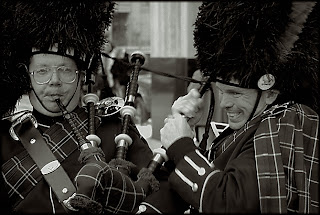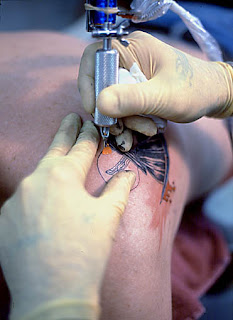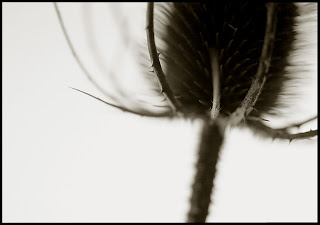Looking back - and forward
I haven't been taking many photos lately for various reasons.
From a photographic perspective I think I ended up in the proverbial slump that many of us may find ourselves in from time to time.
The 'easy' way out would had been to revert back to a gear-focused mind-set 'If I only had another camera body', 'I would do so much better with a wider lens', 'I need a smaller kit so I can carry it with me in my pocket at all times', etc, etc... None of those reasonings are particularly wrong or ill-thought out but if you spend too much obsessing about what you have - instead of using what you do have - you will end up chasing that magic bullet as all possible photo opportunities passes you by.
Having said all that let me now crawl to the cross to confess that I am considering a change in gear.. Well, maybe not as much a change as an addition.
I have used manual rangefinder cameras almost exclusively for the past three-four years or so. I love the way they operate, look and the results they can produce but there have also been so many occasions where I felt limited in what I could reach for photographically.
A 35mm rangefinder camera has a realistic FL reach between 28 and 90mm. Sure, some go wider and longer but it's within this range that most people end up. Including me.
I started thinking about the camera I used when I got into photography as a hobby back in 1997-98 - the Canon A2e (or EOS5 depending on where you live).
It was a auto-zoom, eye-focus assist, auto-exposure SLR. Completely battery dependent and had a significant amount of plastic in its body. Thing is - I loved taking photos with it.
For a year I used nothing but a 50/1.8 lens on it and loved combining a bit of manual foot-zooming with the luxury of having the camera calculate the shutter speed for me and place the focus where I wanted.
Looking back at some of the photos I took then I see that they are not significantly different or even better than the ones I may take today but I remember the ease of taking them and the 'luxury' of taking a macro, zoom, super wide at the turn of the already equipped lens.
Some of the photos I dug out, from those days;
 This was one of the first photos I was thinking about when looking back at my SLR-auto-everything days.
This was one of the first photos I was thinking about when looking back at my SLR-auto-everything days.
I remember taking it at the St Patrick's day parade in Chicago around 1998-1999 and also I remember what a split second scene it was and how the auto-focus, auto-exposure and zoom didn't help me to take the photo but enabled me to. Had I been carrying one of my rangefinder cameras I would not had been to focus and take the photo before the moment had disappeared. Now, I place a huge emphasis on 'I' in the previous sentence as I am convinced that there are other photographers out there that would had been able to take this photo three times using a rangefinder camera - but I'm not one of them.
 The above photo "American Religion" was taken around 2000 at a pre-season game between The Raiders and The 49ers. I was at the extreme long end of my tele-zoom at 300mm when I took this photo. Once again, something that I would not had been able to capture using my existing gear preference.
The above photo "American Religion" was taken around 2000 at a pre-season game between The Raiders and The 49ers. I was at the extreme long end of my tele-zoom at 300mm when I took this photo. Once again, something that I would not had been able to capture using my existing gear preference.
 Taking this photo, in some late-night open tattoo parlor in Chicago, I greatly benefited from close focusing capabilities. The customer was a very drunken man all dressed up in a cowboy outfit and t this point he had already passed out. I remember asking the tattoo artist if he thought the customer would be surprised in the morning when he sobers up and his reply was 'Most of my customers are'.
Taking this photo, in some late-night open tattoo parlor in Chicago, I greatly benefited from close focusing capabilities. The customer was a very drunken man all dressed up in a cowboy outfit and t this point he had already passed out. I remember asking the tattoo artist if he thought the customer would be surprised in the morning when he sobers up and his reply was 'Most of my customers are'.
 Another close-up/macro photo.
Another close-up/macro photo.
Obviously not easily attainable using a rangefinder camera (possible - but not easily).
I had just moved to California and was at 'home' at a hotel room with a really bad cold. As I started to recover I got bored. Pulled out some weeds that I had picked up in Oregon during a road trip there and placed them on a lightbox, rigged up the camera on a tripod and stacked two or three close-focusing filters on the lens and shot away.
When my A2e eventually passed away after having been crushed in the overhead compartment on some flight I ended up not taking photos for a long time. I got back into the hobby a few years later after having acquired a Hasselblad and later a range of rangefinder cameras. While I truly have - and continue to - enjoy using manual cameras I also recognize that they come with significant limitations. I think part of my stubbornness from trying to force these cameras to be my only tools comes from knowing the history of them and how well they have been put to use throughout the past decades. If they were good enough for Henri Cartier-Bresson and Robert Kapa why would I need anything else?
I think this may be the core of an issue that many users of either/or rangefinder/classic cameras sometimes face.
If you fail to get images that excites you using such equipment it often triggers two responses;
a) buy more lenses/filters/bodies - because obviously it must be 'not enough gear' that is preventing you from achieving your goals - or,
b) seriously doubting your photographic capabilities and end up disillusioned and less inclined of picking up that M3/ZI/R2.
If the above applies then maybe you are just like me, being too stubborn in trying to fit that square peg into a much too round hole.
I will most likely keep my square pegs - but I am seriously looking at round-peg options to add to them.
Thing is, they will require batteries..
From a photographic perspective I think I ended up in the proverbial slump that many of us may find ourselves in from time to time.
The 'easy' way out would had been to revert back to a gear-focused mind-set 'If I only had another camera body', 'I would do so much better with a wider lens', 'I need a smaller kit so I can carry it with me in my pocket at all times', etc, etc... None of those reasonings are particularly wrong or ill-thought out but if you spend too much obsessing about what you have - instead of using what you do have - you will end up chasing that magic bullet as all possible photo opportunities passes you by.
Having said all that let me now crawl to the cross to confess that I am considering a change in gear.. Well, maybe not as much a change as an addition.
I have used manual rangefinder cameras almost exclusively for the past three-four years or so. I love the way they operate, look and the results they can produce but there have also been so many occasions where I felt limited in what I could reach for photographically.
A 35mm rangefinder camera has a realistic FL reach between 28 and 90mm. Sure, some go wider and longer but it's within this range that most people end up. Including me.
I started thinking about the camera I used when I got into photography as a hobby back in 1997-98 - the Canon A2e (or EOS5 depending on where you live).
It was a auto-zoom, eye-focus assist, auto-exposure SLR. Completely battery dependent and had a significant amount of plastic in its body. Thing is - I loved taking photos with it.
For a year I used nothing but a 50/1.8 lens on it and loved combining a bit of manual foot-zooming with the luxury of having the camera calculate the shutter speed for me and place the focus where I wanted.
Looking back at some of the photos I took then I see that they are not significantly different or even better than the ones I may take today but I remember the ease of taking them and the 'luxury' of taking a macro, zoom, super wide at the turn of the already equipped lens.
Some of the photos I dug out, from those days;
 This was one of the first photos I was thinking about when looking back at my SLR-auto-everything days.
This was one of the first photos I was thinking about when looking back at my SLR-auto-everything days.I remember taking it at the St Patrick's day parade in Chicago around 1998-1999 and also I remember what a split second scene it was and how the auto-focus, auto-exposure and zoom didn't help me to take the photo but enabled me to. Had I been carrying one of my rangefinder cameras I would not had been to focus and take the photo before the moment had disappeared. Now, I place a huge emphasis on 'I' in the previous sentence as I am convinced that there are other photographers out there that would had been able to take this photo three times using a rangefinder camera - but I'm not one of them.
 The above photo "American Religion" was taken around 2000 at a pre-season game between The Raiders and The 49ers. I was at the extreme long end of my tele-zoom at 300mm when I took this photo. Once again, something that I would not had been able to capture using my existing gear preference.
The above photo "American Religion" was taken around 2000 at a pre-season game between The Raiders and The 49ers. I was at the extreme long end of my tele-zoom at 300mm when I took this photo. Once again, something that I would not had been able to capture using my existing gear preference. Taking this photo, in some late-night open tattoo parlor in Chicago, I greatly benefited from close focusing capabilities. The customer was a very drunken man all dressed up in a cowboy outfit and t this point he had already passed out. I remember asking the tattoo artist if he thought the customer would be surprised in the morning when he sobers up and his reply was 'Most of my customers are'.
Taking this photo, in some late-night open tattoo parlor in Chicago, I greatly benefited from close focusing capabilities. The customer was a very drunken man all dressed up in a cowboy outfit and t this point he had already passed out. I remember asking the tattoo artist if he thought the customer would be surprised in the morning when he sobers up and his reply was 'Most of my customers are'. Another close-up/macro photo.
Another close-up/macro photo.Obviously not easily attainable using a rangefinder camera (possible - but not easily).
I had just moved to California and was at 'home' at a hotel room with a really bad cold. As I started to recover I got bored. Pulled out some weeds that I had picked up in Oregon during a road trip there and placed them on a lightbox, rigged up the camera on a tripod and stacked two or three close-focusing filters on the lens and shot away.
When my A2e eventually passed away after having been crushed in the overhead compartment on some flight I ended up not taking photos for a long time. I got back into the hobby a few years later after having acquired a Hasselblad and later a range of rangefinder cameras. While I truly have - and continue to - enjoy using manual cameras I also recognize that they come with significant limitations. I think part of my stubbornness from trying to force these cameras to be my only tools comes from knowing the history of them and how well they have been put to use throughout the past decades. If they were good enough for Henri Cartier-Bresson and Robert Kapa why would I need anything else?
I think this may be the core of an issue that many users of either/or rangefinder/classic cameras sometimes face.
If you fail to get images that excites you using such equipment it often triggers two responses;
a) buy more lenses/filters/bodies - because obviously it must be 'not enough gear' that is preventing you from achieving your goals - or,
b) seriously doubting your photographic capabilities and end up disillusioned and less inclined of picking up that M3/ZI/R2.
If the above applies then maybe you are just like me, being too stubborn in trying to fit that square peg into a much too round hole.
I will most likely keep my square pegs - but I am seriously looking at round-peg options to add to them.
Thing is, they will require batteries..
